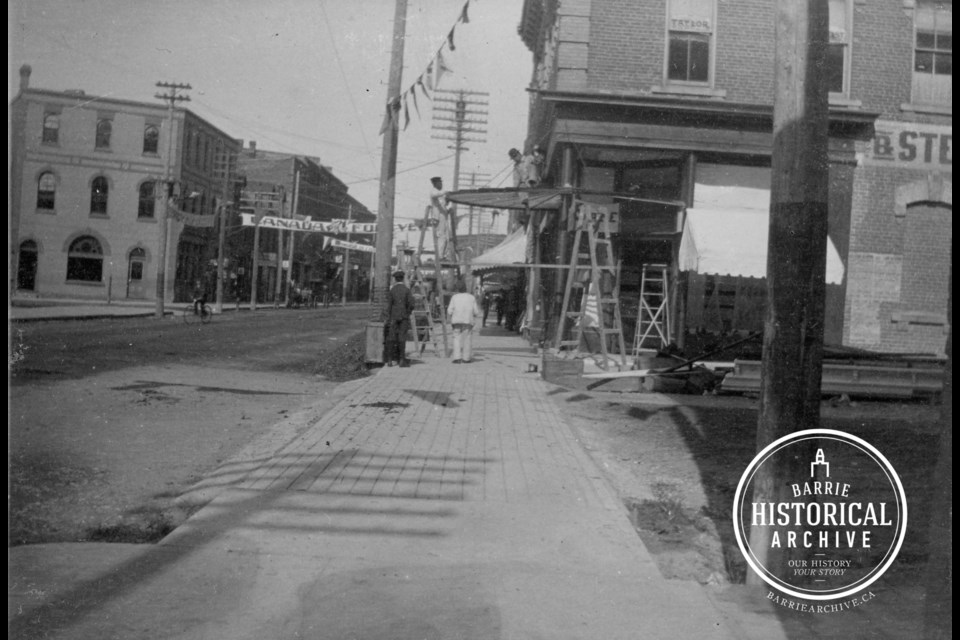This ongoing series from Barrie Historical Archive curator Deb Exel shows old photos from the collection and one from the present day, as well as the story behind them
James Vair and Co.
This image reminds us of a time when awnings were a very common sight on downtown businesses.
Awnings not only added visual appeal to streetscapes, but they provided an important functional purpose in the days before air conditioning or tinted windows.
These simple, climate-control features not only filtered out the bright rays, but they still permitted daylight in as well as air movement in and out of buildings. Store awnings protected window shoppers from the rain and prevented window displays from fading as a result of prolonged exposure to sunlight.
Awnings were considered as fashionable as curtains, blinds or shutters when it came to window dressings. A few examples can be seen in these old photos of the Queen’s Hotel and shops along Dunlop Street.
Our feature photo from 1904 is captioned, ‘Glazing awning at Jas. Vair Store’, starring P. Love (who had a paint store opposite the Queen’s Hotel), O.B. Patterson and N. Buchanan, shows a traditional canvas awning on one side and a more elaborate style at the corner of the building. Another view of Vair store awnings is seen here.
This building at the corner of Dunlop Street East and Owen Street has long been associated with the banking industry (Bank of Toronto, Municipal Savings and Loan, National Bank). Prior to housing Vair’s large and successful department store, it was Henderson’s Hardware.
Born in Inverkeithing Fifeshire, Scotland, James Vair came to Canada with his family at the age of 12. His father, William, was a florist and had greenhouses on Anne Street in an area that became known as Vairville. James worked with his father for a period of time, then as a seedsman with Rennie’s in Toronto, before going into the grocery business, Coulter and Vair, in the 1880s, with William Coulter.
In 1890, the partnership was dissolved and Vair was in business for himself. He took over the property that had been Jonathan Henderson’s hardware store and converted it to his grocery business. He would later expand into the premises next door (later Zellers) for his dry goods business.
Vair would have stores in several towns and cities: Bracebridge, Sault Ste. Marie, Parry Sound, and Toronto.
Groceries were his business, but Vair had significant interests in produce, particularly apples. He had leases on orchards in Simcoe County and in the Annapolis Valley, N.S., and a warehouse in Winnipeg to serve a western market. Vair also exported potatoes from Prince Edward Island.
Besides his position in the community as a prominent businessman, Vair was busy in local politics. As an alderman, Vair proposed that companies with 50 workers and weekly wages totalling $300 receive ‘free water and light’ and a loan repayable within 10 years at four per cent, equal to their investment in land, structures and machinery.
Later, Vair was the first deputy reeve of Barrie in 1908 and mayor in 1909, living in the Pearson House about that time.
With the bylaw for fixed assessment passed, only three companies would meet council’s and the Board of Trade’s approval: the Barrie Tannery, Barrie Carriage Works and Canada Producer and Gas Engine Co. Assistance to the tannery worked out, but the Barrie Bell’s manufacturer did not do well, nor did the Canada Producer company, although the town recovered the $40,000 that was loaned, losing only some interest.
Other achievements during Vair’s term included the extension of the sewer system to Wards 5 and 6; a bylaw to license milk vendors and another for licensing butchers. With the help of debentures, work went forward on extensive construction of cement sidewalks and a large storm sewer along Sophia Street and under Ross Street into Queen’s Park.
Vair’s term as mayor was a hectic one, indeed. Not all of his civic improvements were adopted, however. Vair had proposed a large fountain for Queen’s Park with water sourced from Kidds Creek. This project was not approved, but Vair did manage to have many trees planted in the park.
His other unimplemented suggestion was to build a cribwork along the head of the bay between the water and the railway tracks, to create a roadway. Ironically, in 1940, when alternative routes for Highway 11 through town were being considered, the city engineer recommended the same idea.
Life without awnings made main street a little less colourful and a little less interesting, but they didn’t disappear entirely over the years. We see a few remnants here at the Okay Shoe Repair and Palm Beauty Bar in the 1970s.
Although not so much a climate-control device anymore, awnings are still around today.



